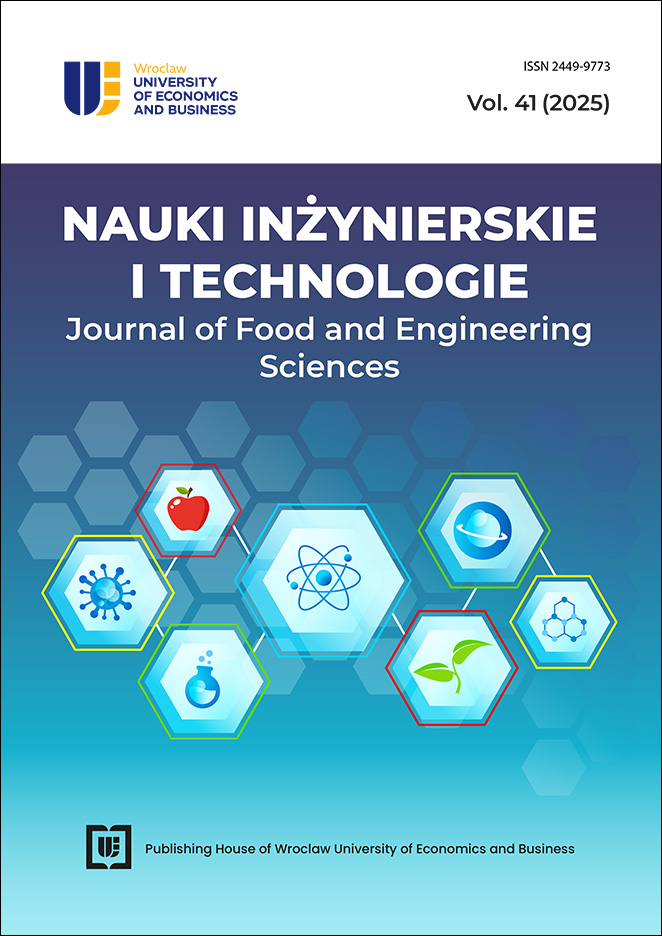Analiza zawartości fosforanów w napojach typu cola i próba oszacowania spożycia fosforanów z tymi napojami przez młodych dorosłych – badanie pilotażowe
DOI:
https://doi.org/10.15611/nit.2025.41.01Słowa kluczowe:
ortofosforany, fosfor, napoje, dodatki do żywności, składniki mineralneAbstrakt
Cel: Celem badań było określenie zawartości ortofosforanów (PO₄³⁻) w napojach typu cola dostępnych w Polsce na rynku wrocławskim, próba oszacowania ilości fosforu (P) spożywanego wraz z napojami przez młodych dorosłych (18-35 lat) oraz zbadanie poziomu wiedzy respondentów na temat źródeł fosforanów w diecie i potencjalnej szkodliwości ich nadmiaru.
Metodyka: Analizę napojów typu cola wykonano za pomocą szybkiego testu reflektometrycznego firmy Merck. Przeprowadzono również badanie ankietowe za pośrednictwem platformy Google Forms.
Wyniki: Badania wykazały, że zawartość PO₄³⁻ wahała się od 125 do 875 mg/l. Badanie ankietowe wykazało, że respondenci mają ograniczoną wiedzę na temat szkodliwości nadmiaru P i jego źródeł w diecie. Deklarowane spożycie napojów typu cola wyniosło od 250 do 9000 ml/tydzień. Najczęściej wybieranymi napojami były Coca-Cola Zero i klasyczna. Średnie spożycie P przez młodych dorosłych z tymi napojami wynosiło od 23 do 267 mg/dzień.
Implikacje i rekomendacje: Według doniesień naukowych, oznaczone dzienne spożycie P nie powinno powodować problemów zdrowotnych. Niemniej jednak należy kontrolować dzienne spożycie tego pierwiastka z różnych źródeł, zwłaszcza w przypadku osób z problemami zdrowotnymi, takimi jak choroby nerek lub niedoczynność przytarczyc.
Oryginalność/wartość: Monitoring zawartości PO₄³⁻ w żywności przetworzonej jest ważny ze względu na wzrastającą popularność tego typu żywności i ocenę ryzyka zdrowotnego związanego z nadmiarem P w diecie.
Pobrania
Bibliografia
Bello, M. A., & Gustavo González, A. (1996). Determination of Phosphate in Cola Beverages Using Nonsuppressed Ion Chromatography: An Experiment Introducing Ion Chromatography for Quantitative Analysis. Journal of Chemical Education, 73(12), 1174-1175. https://pubs.acs.org/doi/10.1021/ed073p1174
Benini, O., D’Alessandro, C., Gianfaldoni, D., & Cupisti, A. (2011). Extra-Phosphate Load from Food Additives in Commonly Eaten Foods: A Real and Insidious Danger for Renal Patients. Journal of Renal Nutrition: The Official Journal of the Council on Renal Nutrition of the National Kidney Foundation, 21(4), 303-308. https://doi.org/10.1053/j.jrn.2010.06.021
Business Insider. (2023). Polacy są wierni kilku markom leków i napojów. Inaczej jest z piwem. https://businessinsider.com.pl/gospodarka/polacy-sa-wierni-kilku-markom-lekow-i-napojow-inaczej-jest-z-piwem/pyxkq4m
Calvo, M., Moshfegh, A., & Tucker, K. (2014). Assessing the Health Impact of Phosphorus in the Food Supply: Issues and Considerations. Advances in Nutrition, 5(1), 104-113. https://doi.org/10.3945/an.113.004861
Calvo, M., & Uribarri, J. (2013). Public Health Impact of Dietary Phosphorus Excess on Bone and Cardiovascular Health in the General Population. The American Journal of Clinical Nutrition, 98(1), 6-15. https://doi.org/10.3945/ajcn.112.053934
Calvo, M., & Uribarri, J. (2017). Phosphorus in the Modern Food Supply: Underestimation of Exposure. In O. Gutiérrez, K. Kalantar-Zadeh, & R. Mehrotra (Eds.), Clinical Aspects of Natural and Added Phosphorus in Foods. Nutrition and Health (pp. 47-76). Springer. https://doi.org/10.1007/978-1-4939-6566-3_4
Chang, A. R., & Anderson, C. (2017). Dietary Phosphorus Intake and the Kidney. Annual Review of Nutrition, 37, 321-346. https://doi.org/10.1146/annurev-nutr-071816-064607
EFSA. (2005). Opinion of the Scientific Panel on Dietetic products, nutrition and allergies [NDA] related to the tolerable upper intake level of phosphorus. EFSA Journal, 3(8), 1-19. https://doi.org/10.2903/j.efsa.2005.233
EFSA. (2015). Scientific Opinion on Dietary Reference Values for phosphorus. EFSA Panel on Dietetic Products, Nutrition and Allergies (NDA). EFSA Journal, 13(7), 1-54. https://doi.org/10.2903/j.efsa.2015.4185
Guarnotta, V., Riela, S., Massaro, M., Bonventre, S., Inviati, A., Ciresi, A., Pizzolanti, G., Benvenga, S., & Giordano, C. (2017). The Daily Consumption of Cola Can Determine Hypocalcemia: A Case Report of Postsurgical Hypoparathyroidism-Related Hypocalcemia Refractory to Supplemental Therapy with High Doses of Oral Calcium. Frontiers in Endocrinology, 8(1), 1-5. https://doi.org/10.3389/fendo.2017.00007
Gutekunst, L. (2010). Water, Water Everywhere, But What to Drink? An Update on Hidden Phosphorus in Popular Beverages. Journal of Renal Nutrition, 20, e1-e5.https://doi.org/10.1053/J.JRN.2009.11.001
Jurkitewicz, K. (2024). Rynek napojów bezalkoholowych w Polsce 2024. Sprzedaż i trendy. Wiadomości Spożywcze. https://wiadomoscispozywcze.pl/artykuly/13824/rynek-napojow-bezalkoholowych-w-polsce-sprzedaz-i-trendy/
Kaczkan, M., Bienias, A., & Małgorzewicz, S. (2018). Realization of Low Phosphate Diet and Hidden Sources of Phosphorus. Forum Nefrologiczne, 11(1), 15-23.
Kalantar-Zadeh, K., Gutekunst, L., Mehrotra, R., Kovesdy, C. P., Bross, R., Shinaberger, C. S., Noori, N., Hirschberg, R., Benner, D., Nissenson, A. R., & Kopple, J. D. (2010). Understanding Sources of Dietary Phosphorus in the Treatment of Patients with Chronic Kidney Disease. Clinical Journal of the American Society of Nephrology, 5(3), 519-530. https://doi.org/10.2215/CJN.06080809
Krekel, C., McClure, S. T., & Chang, A. R. (2016). Improving Estimates of Phosphorus Additive Content: Manufacturers Needed. Journal of Renal Nutrition, 26(5), e27–e30. https://doi.org/10.1053/j.jrn.2016.07.002
Kumar, N., & Ray, S. (2018). Attitude towards Soft Drinks and Its Consumption Pattern: A Study of Gen Y Consumers of India. British Food Journal, 120(2), 355-366. https://doi.org/10.1108/BFJ-05-2017-0320
Lampila, L. (2013). Applications and Functions of Food‐Grade Phosphates. Annals of the New York Academy of Sciences, 1301, 37-44. https://doi.org/10.1111/nyas.12230
León, J. B., Sullivan, C. M., & Sehgal, A. R. (2013). The Prevalence of Phosphorus-Containing Food Additives in Top-Selling Foods in Grocery Stores. Journal of Renal Nutrition, 23(4), 265-270.e2. https://doi.org/10.1053/j.jrn.2012.12.003
Lindley, E., Costelloe, S., Bosomworth, M., Fouque, D., Freeman, J., Keane, D., & Thompson, D. (2014). Use of a Standard Urine Assay for Measuring the Phosphate Content of Beverages. Journal of Renal Nutrition: The Official Journal of the Council on Renal Nutrition of the National Kidney Foundation, 24(6), 353-356. https://doi.org/10.1053/j.jrn.2014.07.002
Mancini, F., Affret, A., Dow, C., Balkau, B., Clavel-Chapelon, F., Bonnet, F., Boutron‐Ruault, M., & Fagherazzi, G. (2017). High Dietary Phosphorus Intake is Associated with an Increased Risk of Type 2 Diabetes in the Large Prospective E3N Cohort Study. Clinical Nutrition, 37(5), 1625-1630. https://doi.org/10.1016/j.clnu.2017.07.025
McCarty, M., & DiNicolantonio, J. (2014). Bioavailable Dietary Phosphate, a Mediator of Cardiovascular Disease, May Be Decreased with Plant-Based Diets, Phosphate Binders, Niacin, and Avoidance of Phosphate Additives. Nutrition, 30(7-8), 739-747. https://doi.org/10.1016/j.nut.2013.12.010
Moser, M., White, K., Henry, B., Oh, S., Miller, E. R., Anderson, C. A., Benjamin, J., Charleston, J., Appel, L. J., & Chang, A. R. (2015). Phosphorus Content of Popular Beverages. American Journal of Kidney Diseases, 65(6), 969-971. https://doi.org/10.1053/j.ajkd.2015.02.330
National Institutes of Health (NIH). (2023). Office of Dietary Supplements. Phosphorus – Health Professional Fact Sheet. https://ods.od.nih.gov/factsheets/Phosphorus-HealthProfessional/#h15
Pacific, R., & Hoefkins, C. (2014). Consumption Pattern, Attitudes and Nutrition Knowledge on Soft Drinks among Belgian Adults. Tanzania Journal of Agricultural Sciences, 13(1), 55-66.
Picard, K., Griffiths, M., Senior, P. A., Mager, D., & Richard, C. (2023). Phosphorus Additives and Their Impact on Phosphorus Content in Foods – An Analysis of the USDAs Branded Foods Product Database. Journal of Renal Nutrition: The Official Journal of the Council on Renal Nutrition of the National Kidney Foundation, 33(3), 443-449. https://doi.org/10.1053/j.jrn.2022.12.007
Regulation (EU) No 1169/2011. (2011). Regulation (EU) No 1169/2011 of the European Parliament and of the Council of 25 October 2011 on the provision of food information to consumers. Official Journal of the European Union, 18-63. https://eur-lex.europa.eu
Ritz, E., Hahn, K., Ketteler, M., Kuhlmann, M., & Mann, J. F. E. (2012). Phosphate Additives in Food – A Health Risk. Deutsches Arzteblatt International, 109(4), 49-55. https://doi.org/10.3238/arztebl.2012.0049
Sherman, R. A., & Mehta, O. (2009). Dietary Phosphorus Restriction in Dialysis Patients: Potential Impact of Processed Meat, Poultry, and Fish Products as Protein Sources. American Journal of Kidney Diseases, 54(1), 18-23. https://doi.org/10.1053/j.ajkd.2009.01.269
Stoś, K., Woźniak, A., Wojtasik, A., Rychlik, E., Ziółkowska, I., & Głowala, A. (2024). Składniki mineralne. In E. Rychlik, K. Stoś, A. Woźniak, & H. Mojska (Eds.), Normy żywienia dla populacji Polski (pp. 255-342). Narodowy Instytut Zdrowia Publicznego PZH – Państwowy Instytut Badawczy.
The Coca-Cola Company. (2024a). Coca-Cola Reports Fourth Quarter and Full Year 2023 Results. https://www.coca-colacompany.com/media-center/fourth-quarter-full-year-2023-results
The Coca-Cola Company. (2024b). How Many Drinks Does The Coca-Cola Company Sell Worldwide Each Day? https://www.coca-cola.com/ng/en/about-us/faq/how-many-drinks-does-the-coca-cola-company-sell-worldwide-each-d
The Economic Times. (2024). Mexico: A State in Mexico That Consumes More Coke Than Any Other Place in the World – The Economic Times. https://economictimes.indiatimes.com/news/international/us/a-state-in-mexico-that-consumes-more-coke-than-any-other-place-in-the-world/articleshow/112635370.cms?from=mdr
Trautvetter, U., Ditscheid, B., Jahreis, G., & Glei, M. (2018). Habitual Intakes, Food Sources and Excretions of Phosphorus and Calcium in Three German Study Collectives. Nutrients, 10(2), 171 https://doi.org/10.3390/nu10020171
Uribarri, J., & Calvo, M. (2013a). Dietary Phosphorus Excess: A Risk Factor in Chronic Bone, Kidney, and Cardiovascular Disease? Advances in Nutrition, 4(5), 542-544. https://doi.org/10.3945/an.113.004234
Uribarri, J., & Calvo, M. (2013b). Introduction to Dietary Phosphorus Excess and Health. Annals of the New York Academy of Sciences, 1301. https://doi.org/10.1111/nyas.12302
Vorland, C. J., Stremke, E. R., Moorthi, R., & Gallant, K. H. H. (2017). Effects of Excessive Dietary Phosphorus Intake on Bone Health. Current Osteoporosis Reports, 15, 473482. https://doi.org/10.1007/s11914-017-0398-4
Watanabe, M. T., Barretti, P., & Caramori, J. (2018). Dietary Intervention in Phosphatemia Control-Nutritional Traffic Light Labeling. Journal of Renal Nutrition: The Official Journal of the Council on Renal Nutrition of the National Kidney Foundation, 28(6), e45-e47. https://doi.org/10.1053/j.jrn.2018.04.005
Younes, M., Aquilina, G., Castle, L., Engel, K. H., Fowler, P., Frutos Fernandez, M. J., Fürst, P., Gürtler, R., Husøy, T., Mennes, W., Moldeus, P., Oskarsson, A., Shah, R., Waalkens-Berendsen, I., Wölfle, D., Aggett, P., Cupisti, A., Fortes, C., Kuhnle, G., & Gundert-Remy, U. (2019). Re-Evaluation of Phosphoric Acid–Phosphates – Di-, Tri- and Polyphosphates (E 338–341, E 343, E 450–452) as Food Additives and the Safety of Proposed Extension of Use. EFSA Journal, 17(6). https://doi.org/10.2903/j.efsa.2019.5674
Pobrania
Opublikowane
Licencja
Prawa autorskie (c) 2025 Gabriela Haraf, Jan Dziurbiel

Utwór dostępny jest na licencji Creative Commons Uznanie autorstwa – Na tych samych warunkach 4.0 Miedzynarodowe.





